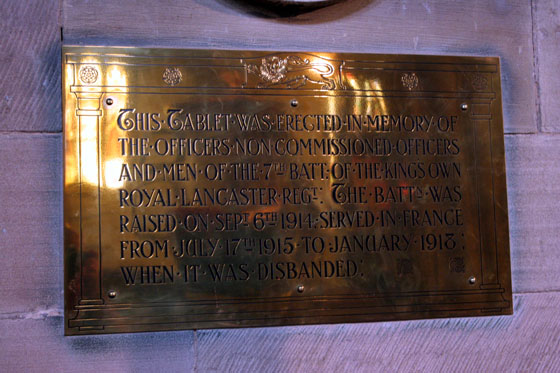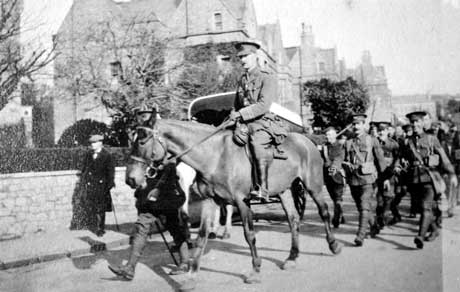World War One7th
Battalion, King's Own Royal Lancaster Regiment
Brass Memorial Tablet
Unusually the Brass Memorial Tablet to the 7th Battalion, King's Own
Royal Lancaster Regiment is located not in the King's Own Regimental
Chapel, but in the main part of the Lancaster Priory Church. This
dates back to 1918 when the Chapel Committee refused the inclusion of
the memorial. In 1929 this set of correspondence discussed the
relocation (or removal) of the memorial. The brass tablet remains
where it was positioned in 1918.

Letter to Lieutenant Colonel Tudor Fitzjohn DSO from Major H
Cooper, Honorary Secretary of the King’s Own Chapel Committee.
Subject:- Regimental Chapel – 7th Battalion Brass
Dear Colonel Fitz John,
I do not know if you have ever been to Lancaster and seen the King’s Own
Regimental Chapel which forms part of the Parish Church. If you have you
will have seen on the wall of the Church, - rear but not in the Chapel,
a brass to the 7th Battalion.
Visitors to the Church and Chapel at once begin to wonder why the 7th
Battalion was not considered worthy to have their memorial in the
Chapel. No one knows better than yourself how very unfair such an
impression is both to the 7th Battalion and to the Regiment.
The facts are these. No brass may be placed in the Chapel without the
permission of the Chapel Committee which consists of retired regular
Officers of the Regiment. After the war money was collected from all
Battalions for a joint Regimental Memorial which took the form of a
stained glass window and a Roll of Honour containing the names of all
King’s Own men who lost their lives.
The 7th Battalion on disbandment approached the Chapel Committee and
asked to place a brass in the Chapel as a Memorial – not to those of the
Battalion who were killed only – but “in memory of the 7th Bn.” The
Chapel Committee took the line that the Regimental Memorial should be a
joint one representing all Battalions and refused the request for a
separate brass.
The Battalion then approached the Vicar who gave his permission to place
the brass in the Church – not realising probably how things stood. I am
afraid there was a lack of tact shown by everybody concerned. But that
cannot be helped now – and it only remains to remove if we can a false
and most unfortunate impression.
The only officer of the 7th Battalion with whom I am now in touch is
Hoyle who agrees with me that something should be done. He approached
Openshaw who is apparently the surviving member of the Committee which
put up this brass, with a view to getting a letter written by me, as
Secretary of the Chapel Committee, suggesting the removal of the brass
to some place in the Chapel. It appears that Openshaw still feels
bitterly on the subject as after an hour and a half’s argument Hoyle
could only get him to the length of saying he would consent if the
Regiment wrote to him.
With the best will in the world I really cannot take on the hopeless
task of trying to persuade the Committee – ten very senior retired
officers – some of them Generals over 70 years of age – to write to
Openshaw to ask his permission to remove the brass – though I feel
fairly confident that they would consent to its removal if properly
approached.
In this impasse I again consulted Hoyle who told me you had more
influence with the officers of the 7th Battalion than anyone else and he
suggested my writing to you to ask your help.
Would it be possible for you to get a letter written on behalf of the
officers of the 7th Battalion asking for the removal of the brass? I am
sorry to bother you about this – which in some way seems a small matter
– but yet one which I feel sure you will agree with me should be put
right.
H Cooper Major
Honorary Secretary, The King’s Own Chapel Committee.
Bowerham Barracks, Lancaster
15th April 1929.
Letter from Captain Gerald N Openshaw, to Captain Charles Wingrove,
2nd May 1929
My dear Charles,
Thank you for your letter and enclosure of yesterdays date.
I suppose you know more of the original idea of the brass tablet than I
do. My first knowledge of it was a letter from Pedder when I was in
hospital in 1918 enclosing a cheque for £40 to erect a brass in
Lancaster Parish Church to the 7th Batt. Knowing there was a King’s Own
Memorial Chapel attached to the church I wrote to Bowerham Barracks and
informed them what was proposed, but they refused …. in the chapel and
suggested (or rather asked) that the money be handed to them for their
Central fund with which the stained glass window and Roll of Honour have
now been raised. This I naturally refused as the money was sent solely
as a battalion and not a regimental memorial. In their refusal to accede
to my request I wrote Canon Bandsley who was Vicar of Lancaster, and
whom I believe, was a representative on the King’s Own Chapel Committee.
He agreed to the brass being erected in the church. The usual
formalities of having the design approved and the faculty obtained from
the Ecclesiastical Commissioners were carried and the memorial was duly
dedicated. That is my part of the proceedings and my further remarks
below refer to the paragraphs in Major Coopers letter to Colonel
Fitzjohn of the 15th inst…..
The gist of all this long ‘appreciation of the situation’ is simply that
the King’s Own Chapel Committee are asking us to do precisely what I
asked them to do in 1918. It has apparently taken them more than 10
years to find out they were wrong when they refused to accede to our
request to put it in the Chapel.
I have been pig headed over the matter but feel that no apology is due
from me for the stand I made it isn’t my brass to move about and I never
would agree to its removal without the general consent of those for whom
it was erected.
Yours aye
Gerald N Openshaw
* Captain The Reverend R W Pedder, 7th King’s Own.
Letter from Captain Gerald Newbold Openshaw, to Captain Charles
William Wingrove, 8th May 1929
My dear Charles
Thanks for yours of the 5th inst. I am glad you uphold the attitude I
adopted regarding the brass. The enclosed letter which I unearthed (and
which please return) is the cream of the whole joke for the reason given
by Lieutenant Colonel Thorne in his letter of 10th June 1918. You will
notice that he first says the Committee approve the wording, and later
says they are sorry there is no space for the tablet. (The size of our
tablet by the way is 30” by 18”). Since the chapel has not been enlarged
how can they now find room for it? You will notice that Colonel Thorne
even offers me advice as to what is necessary for the erection of the
brass in the body of the Church, so it is obvious that they were advised
that failing it being put in the Chapel we wanted it in the Church.
Hence were does the lack of tact mentioned by Major Cooper arise?
Did I tell you that at the time I sent the balance of money, after
paying for the brass, amounting to £7-15-0 to the KO War Memorial Fund.
If we get the opportunity when Colonel Fitzjohn comes to you I will
bring all the other papers for your perusal.
The more I think about the more inclined I am to say “Let the brass stay
where it is!”
Cheers
Yours
Gerald N Openshaw
Letter from Captain Gerald Openshaw, to Captain Charles Wingrove
8th May 1929
My dear Charles,
I have scribbled a separate letter about the 7th Battalion Brass which
you can pass the copy to Fitzjohn.
It really seems to me by the wording of Major Coopers letter (the last
sentence in paragraph 4 and the word “removal” in paragraph 9) that they
are trying to “double cross” us and get it out of the church and not put
it in the chapel. This may be a base suspicion, but I know from Hoyle’s
remarks that they are very peeved about the tablet being in the Church.
Hoyle is very thick with some of the fellows at the Depot and his
remarks about an hour and a halfs argument with me are all rot – I will
speak to him about it when I see him!
I should like to meet you and Fitzjohn if he comes up for the weekend
and we can discuss the matter.
We are all very fit at home and trust you and yours are also. The Cotton
trade is in a mess and I ma not making a fortune of it. Hope trade is
brisk with you.
Drop me a line if Fitzjohn is coming.
Gerald N Openshaw.

Officer Commanding No. 1 Company, Captain Gerald N Openshaw
at Clevedon circa February 1915. Sergeants Warner and Shearson to
the right of the picture.
Accession Number KO1769/01-25
Only a proportion of our collections
are on display at anyone time. Certain items are on loan for display
in other institutions. An appointment is required to consult any of
our collections which are held in store.



